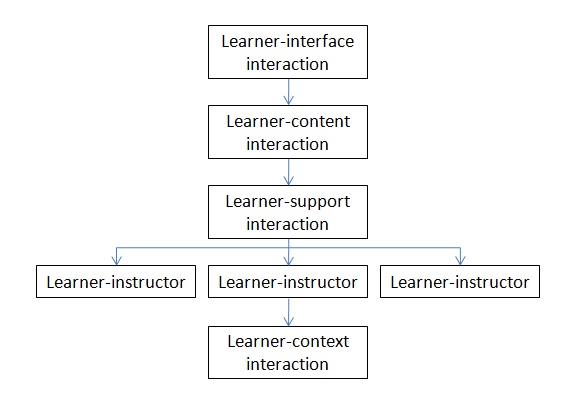Enhancing Meaningful Interaction in Online Learning
Implications of constructivism for online learning
- Learning should be an active process. Keeping learners active while participating in meaningful activities results in high-level processing, which facilitates the creation of personalised meaning. Asking learners to apply the information in a practical situation is an active process, and facilitates personal interpretation and relevance.
- Learners should construct their own knowledge rather than accepting that which is given by the instructor. Knowledge construction is facilitated by good interactive online instruction, since the students will have to take the initiative to learn and to interact with other students and the instructor.
- Collaborative and cooperative learning should be encouraged to facilitate constructivist learning. Working with other learners gives learners real-life experiences of working in a group, and allows them to use their metacognitive skills. Learners will also be able to use the strengths of other learners, and to learn from others. When assigning learners for group work, membership should be based on the expertise level and learning style of individual group members, so that individual team members can benefit from one another's strengths.
- Learners should be given control of the learning process. There should be a form of guided discovery where learners are allowed to make decisions on learning goals, but with some guidance from the instructor.
- Learners should be given time and opportunity to reflect. When learning online, students need the time to reflect and internalise the information. Embedded questions on the content can be used throughout the lesson to encourage learners to reflect on and process the information in a relevant and meaningful manner; or learners can be asked to generate a learning journal during the learning process to encourage reflection and processing.
- Learning should be made meaningful for learners. The learning materials should include examples that relate to students, so that they can make sense of the information. Assignments and projects should allow learners to choose meaningful activities to help them apply and personalise the information.
- Learning should be interactive to promote higher-level learning and social presence, and to help develop personal meaning. Interaction is also critical to creating a sense of presence and a sense of community for online learners, and to promoting transformational learning. Garrison (1999) claimed that it is the design of the educational experience that includes the transactional nature of the relationship between instructor, learners, and content that is of significance to the learning experience.
You have learnt a number of reasons why on-learning situation should involve active interaction. Is this equally relevant to a classroom?
Observe a classroom situation and record the different kinds of interactions occurring in the class.
How does the teacher manage to create/facilitate such interactions?
Types of iInteraction
Different kinds of interaction will promote learning at different levels. Hirumi (2002) proposed a framework of interaction in online learning that consists of three levels.
- Level one is learner-self interaction, which occurs within the learner to help the learner monitor and regulate their own learning.
- Level two interactions are learner-human and learner-non-human interactions, where the learner interacts with human and non-human resources.
- Level three is learner-instruction interaction, which consists of activities to achieve a learning outcome.
We should go one step further and propose interactions that go from lower-level to higher level interactions based on behaviourist, cognitivist, and constructivist schools of learning. See Figure 2.4.
Learner-interface interaction: At the lowest level of interaction, there must be learner-interface interaction to allow the learner to access and sense the information. The interface is where learners use their senses to register information in sensory storage. In online learning, the interface is with the computer to access the content and to interact with others.
Learner-content interaction: Once learners access the online materials, there must be learner content interaction to process the information. Learners navigate through the content to access the components of the lesson, which could take the form of pre-learning, learning, and post-learning activities. These activities could access reusable learning objects from a repository or they could use content that has been custom created by the designer or instructor. Students should be given the ability to choose their own sequence of learning, or should be given one or more suggested sequences.

As online learners interact with the content, they should be encouraged to apply, access, analyse, synthesise, evaluate, and reflect on what they learn (Berge, 2002). It is during the learner-content interaction that learners process the information to transform it from short-term to long-term memory. The higher the level of processing, the more associations are made in long-term memory, which results in higher-level learning .
Learner-support interaction: As learners work through the content, they will find the need for learner support, which could take the form of learner-to-learner, learner-to-instructor, instructor-to-learner, and learner-to-expert interactions (Moore, 1989).
Learner-context interaction: There should be strategies to promote learner-context interaction to allow learners to apply what they learn in real life so that they can contextualise the information. Learner-context interaction allows learners to develop personal knowledge and construct personal meaning from the information.
Example:
Type
1. ...............................................
Description:
Example:
Type
2. ...............................................
Description:
Example:
Type
3. ...............................................
Description:
Example:
Type
4. ...............................................
Description:
Example:
Licensed under the Creative Commons Attribution 3.0 License